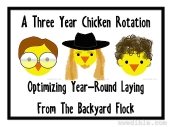Well I'll try and answer in order:
1. Butchering one pig will be quite a bit of food for your family. We have 5 and one pig with a deer or two and we're good for the year. Two would be ok but they take up a bunch of space so don't forget about freezer/storage space.
2. Selective breeding can be done with mixed breeds of pigs or crosses just as well as heritage breeds. See which ones grow faster and save those for breeding purposes. The boar has 1/2 to do with it so unless you get a good proven boar to start with you might find this harder to control.
3. Pigs unless rotated around in paddocks are hard to use to build up quality in soil. Stocking density is the key...and that varies a lot as well. Pigs are rototillers by nature so allow as much space per pig as you can and have some seed handy to follow rotations so the bare land they leave behind doesn't erode. If you're setting up your paddocks, get them set up first if that is your goal, and rotate by eyes...meaning if it looks like they need switched, do it. Otherwise you could have a pasture to raise them in but the nutrients will take longer to build up over a large area and pigs will not disperse "crap" equally for you...they'll typically pick a spot they prefer and dump in that general area.
4. Be careful of this. I've done this and unless you have every detail worked out (costs, butchering, packaging, delivery, which pig is who's) then it can get dicey in a hurry. On a small scale like ours I use an input method on charging...what goes into raising each pig from birth/bought to slaughter. Then I add my fees for raising the animal. Time is not free so don't sell yourself short. I typically charge about $100 plus input so I make $100 per pig at slaughter. People in my area have come out of the woodwork wanting pigs, chickens, and whatever else I have on the farm so be ready to say "no" if you get hit hard with inquiries.
5. Feeder pigs are what most do in my area and they bring in a good price...I'd lean heavy on that before selling breeding stock...but that's just me. If I have a good breeder I'm not selling her, she'd building up my own herd.
Hope it's clear as mud!



